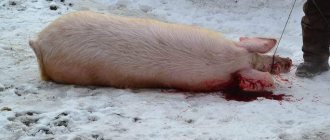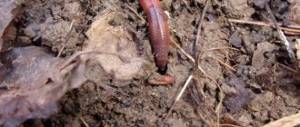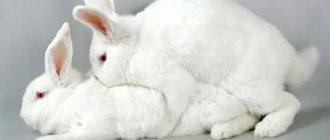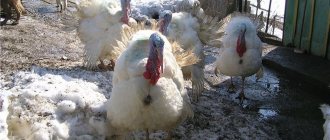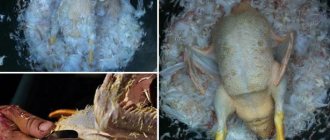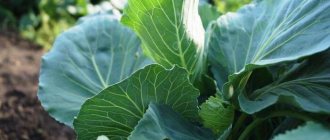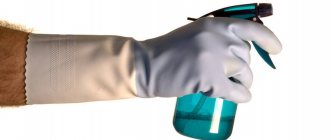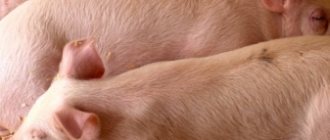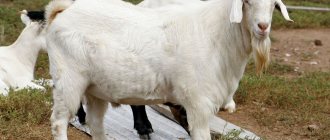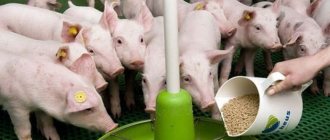Sunflower cake: a close acquaintance with a unique additive
Makukha (common name) is obtained during the processing of sunflower seeds. Oil is extracted from them under pressure, and the remaining pressing is used as feed. Therefore, the quality of sunflower cake depends on 2 factors: the type of crop and the technology of its processing.
An excellent quality product will have a brown tint. In addition, it should have a slight smell of sunflower oil.
Such features of the crown indicate that it contains a sufficient amount of:
- polyunsaturated fatty acids;
- phospholipids;
- mineral elements - iron, zinc, calcium and phosphorus;
- vitamins E, A and B.
This food is highly nutritious due to its low oxidation state. It also contains up to 5-18% fiber and more than 6% fatty acids. All of these components have a positive effect on the development and growth of young animals.
Along with this, sunflower cake contributes to:
- hanging immunity of livestock;
- excellent functioning of the reproductive organs of mammals;
- egg production of poultry;
- rapid growth of muscle mass;
- improvement of metabolic processes in the body of animals.
How to replace sunflower cake in compound feed? As an alternative, farmers often use waste obtained from the processing of rapeseed, cotton, camelina and winter rape.
However, the additive cannot be used arbitrarily. It is necessary to adhere to the exact recipe for preparing feed. Overdose has a negative impact on the health of livestock. It is worth remembering that animal meat or other product obtained from it will eventually have an unpleasant odor or taste. Therefore, you need to follow the recommendations for preparing feed.
Why is it used in agriculture?
Also check out these articles
- Radish Zhara description and characteristics of the variety
- Carrot variety Shantane
- Plum variety Morning
- Foxy Chick Chickens
Sunflower cake is one of the most affordable and very useful components of the diet of animals and birds, which is why it is very popular in agriculture. What is its use?
Why is cake used in agriculture?
- It has many useful substances necessary for both cattle and poultry, pigs, rabbits;
- Has a positive effect on the egg production of birds (ducks, chickens, geese, turkeys);
- Increases the reproductive function of animals and birds;
- Normalizes the body's metabolic processes;
- Sunflower cake is one of the factors for the rapid growth of young animals;
- Reduces the risk of diseases even during epidemics.
Interesting!
Oddly enough, cake is much healthier than fresh sunflower seeds.
Livestock diet: dosage of sunflower cake application
The characteristics of the body of each animal require different technologies for their cultivation. Nevertheless, sunflower cake is a mandatory ingredient in all feeds. At the same time, many are interested in whether it is possible to give the maca to pigs and other animals.
The whole secret is in the dosage for each of them:
- Turkeys. For fattening, up to 15% of the additive is added; young animals will only need 5-7% per day.
- Pigs, piglets. Every day, growing individuals are given up to 300 g, and pregnant/lactating females - up to 600 g. Males are given up to 1 kg of supplement per day.
- Sheep. For the full development of the animal and rapid hair growth, they are given up to 10% supplement.
- Geese. The daily norm for young geese is 17%.
- Laying ducks. The daily diet includes up to 8%. Growing offspring need about 3-7%.
- Cows, calves. Cow cake is used in a ratio of 1:4 of the total amount of feed. Dairy cattle should be given up to 4 kg daily.
- Rabbits. At the age of 30 to 160 days, their daily rate is 13%.
- Goats. Lactating females are prescribed up to 300-500 g of the supplement, and growing females - 200-300 g.
- Hens and chicks. Is it possible to give chicken cakes? Experts advise adding macadamia to the bird’s diet in moderation. For adults, the dosage is 20%, and for young animals - 15%.
- Horses. Working stallions are given up to 2-3 kg of this supplement every day.
Due to its properties and structure, makha is very quickly absorbed by the animal’s body. It is also successfully used as bait for fish. Once in the water, the cake sticks become soaked, crumble along the river and emit a pleasant aroma. This attracts fish to the source of a tasty treat.
DIY recipes for making compound feed
Of course, most farmers buy ready-made feed for their livestock. However, knowing the proportions for preparing such complementary foods, you can significantly improve the growth of livestock.
Here are some recipes for such “dishes” (all data are given in percentages):
- For calves. You will need 24 barley, 21 bran, 20 sunflower cake, 13 wheat, 10 peas.
- For adult rabbits. You need 30 herbal flour, 29 oat flour, 15 barley, 13 oil cake, 11 wheat bran. Also add table salt and chalk, 0.5% of each component.
- For fattening piglets. Wheat is added up to 41, barley - 30, oil cake - 10, bran together with oats - 7, peas - 6.
- For chickens, broilers. Take 35 barley, 30 wheat, 10 peas, 9 bran, 5 cakes and feed yeast each. In addition, chalk and sulfur are added here up to 2.2 (of each ingredient), fish meal - 3.5 and Premix.
- For laying hens. You will need 44 wheat, 30 barley, 15 oil cake and 6 oatmeal.
The main components in feed can be replaced only with equivalent crops. They are mainly divided into 3 groups: cereals, legumes and oilseeds.
In addition, some farmers successfully use another recipe for fattening pigs (with a weight of 45-75 kg). Thanks to this diet, the average daily weight gain will be more than 700 g.
To do this they mix (%):
- barley and corn (1:1) - 73.5;
- wheat bran - 74;
- cake - 2.8;
- peas in combination with herbal flour - 2% each;
- meat and bone (fish) meal (1:1) - 1.9;
- chalk - 1;
- salt - 0.5.
For better results, add zinc and iron sulfate. For 1 ton of prepared feed, add 100 g of each ingredient. Be sure to add 15 g of copper and manganese sulfate, as well as about 10 g of Biomycin.
Cobalt chloride in a dosage of 5 g, as well as potassium iodide - 2 g, are very useful for livestock.
Necessary gear
Ready makushchatnikTo make a makushchatnik, the following equipment is required:
- any metal weight measuring 25×15 (width up to 10 mm);
- several rubber bands;
- wire;
- fishing line (0.4mm up to 70 m in length);
- 2 hooks;
- swivel clasp for spinning;
- hard pressed cake;
Next, we assemble the future makushatnik, which consists of the following steps:
- A wire is attached to a metal weight so that two wire rings are formed on the sides.
- Two elastic bands are put on the resulting structure so that they are under the wire.
- A piece of compressed cake is taken, which should be slightly smaller in size than a metal bar and placed on top of the plate under the rubber bands.
- The prepared swivel is attached to any of the wire rings.
- 2-4 hooks are attached to the second ring, which are pressed into the top of the head for camouflage.
- The resulting structure is attached to the main fishing line.
Secrets of storing sunflower cake
It is worth knowing that the ground additive cannot be stored for a very long time. The main reason is that this product has excellent hygroscopic properties. Increased humidity promotes the rapid breakdown of triglycerides of fatty acids. As a result of their breakdown, glycerol is released, as well as other ether compounds. Under the influence of mycelium spores, as well as bacteria, the makha becomes unusable and emits an unpleasant odor.
In this regard, it is necessary to adhere to the basic rules for storing sunflower cake at home:
- Avoid direct sunlight on the feed product.
- Adhere to humidity standards. The maximum figure is 12%. If the room is very damp, the product may rot or acquire a bitter taste.
- Place bags of sunflower meal away from heat sources.
- The room should be equipped with ventilation/exhaust units or ventilated regularly.
- Stir the additive mixture periodically to prevent condensation from forming.
To store sunflower cake, use ordinary bags, which are stacked. In some cases, the makukha is placed in a dry, warm room in the form of a mound.
Before packaging the cake, experts advise heat treatment of the feed. If this is done in winter, then the product is heated to 35˚C. In summer, take into account the air temperature outside and add 5˚C to this indicator. Taking into account the above recommendations for the use and storage of sunflower cake, you can achieve excellent results in keeping livestock.
It is beneficial to feed domestic animals with the products that remain from seed processing - cake. What types of food there are, how to use it and what to pay attention to, we will consider further.
Sunflower seeds and their parts are useful for feeding pets
How to do it yourself?
You can prepare tackle based on cake at home. To do this, you need to prepare in advance all the elements that will be used to make your handmade dough.
What is necessary:
- seeds;
- meat grinder or coffee grinder;
- weight for pressing;
Cooking makukha at home is not a difficult task and consists of several stages:
- We take the prepared seeds and lightly fry them so that they get an attractive aroma.
- Then we pass the roasted seeds through a meat grinder or coffee grinder and get a powder consistency.
- To prepare the pressed cake, place it under the prepared load and put it in the oven to harden the cake.
Types of Sunflower Seed Feeds
Sunflower is a Pancake week crop that is widespread in our country and is widely used not only as food for people, but also as feed for livestock. Animals need vitamins and nutrients, which are abundant in this plant.
Waste from seed processing is used to feed animals:
- Husk is the hard black shell that remains after peeling. Added to roughage.
- Meal is a by-product of oil production using the extraction method.
- Cake is the solid component that remains after pressing the seeds.
Cake - a healthy food supplement
- Source of vitamins and minerals.
- Protein supplier.
- It's inexpensive.
- Easy to buy in our country.
Sunflower cake is most often used, let’s talk about it in more detail.
Cake for animals - a healthy and inexpensive treat
Sunflower cake is used to feed pigs, cattle, and chickens because it is a healthy, valuable in terms of nutrients and cheap feed that is available all year round. The product can be obtained not only from black seeds, but also from other oilseed plants. In Russia, the following types of cake are also used:
- Soy.
- Flaxseed cake.
- Rapeseed.
Different types of cake are added to animal food
Finding them is more difficult, but sunflower can be bought not only in places that sell feed, but also at oil mills or oil production plants. In addition, speaking about which cake is better, it is worth noting that during the production of soybean and rapeseed, the final raw materials may contain anti-nutritional components (due to a violation of technology or low-quality raw materials), which negatively affect the health of animals.
For animals in our region, sunflower cake is preferable, the beneficial properties of which are as follows:
- Up to 7% fat in the composition, which provides high nutritional value.
- Up to 30-40% of the protein necessary to build muscle mass in animals.
- Contains active substances: tryptophan, arginine, lysine, etc.
- It contains the following vitamins: E, D, B3-B5, carotene and minerals: potassium, iron, manganese, copper, zinc.
Due to the fact that it contains little fiber (due to screening out the husks), feeding the cake does not cause digestive problems in animals.
We learned what cake is and what its composition is. How does using it in food affect your health?
- Immunity becomes stronger.
- The reproductive system works well.
- Egg production increases.
Include the cake in your birds' food, and they will delight you with increased egg production
- Metabolic processes improve.
- Muscle mass is gained quickly.
Diet of piglets, pregnant and lactating sows
The composition of pig feed for pregnant and lactating sows must be enriched with vitamin and mineral supplements. The same applies to organizing a balanced diet for piglets that are just beginning to wean off breast milk. commercially produced dry food packaging
For successful feeding of pregnant and lactating sows, it is necessary to choose feed mixtures with a high protein content. It is also desirable that the prepared food contains an increased percentage of calcium, since during feeding and gestation of piglets, sows are washed out of this valuable substance from the body.
Piglets need to be gradually introduced to dry food in granules. For babies, special prestarter feed mixtures are produced, from the English word “pre starter” - beginner. It needs to be diluted to the consistency of thick porridge, so that piglets accustomed to liquid food will feel comfortable. When choosing a starting feed mixture for young animals, you should pay attention to its composition.
Babies especially need vitamins. It is advisable to purchase feed fortified with vitamin D, since with a deficiency of this vitamin, young animals do not gain weight well. If animals do not eat industrially produced “baby food” well, you can prepare the mash yourself. When the piglets grow up, they will begin to willingly eat store-bought food.
If the pig is carrying or nursing piglets, it is necessary to increase the frequency of feeding and the volume of one serving. However, you should not feed a pig that is about to farrow too heavily, as this may cause farrowing problems.
Dry combination food should be stored in a dry and dark place. Rooms with high air humidity are not suitable for this purpose, because dry food granules absorb moisture well and deteriorate. Damp food becomes completely unfit for consumption because harmful bacteria and mold fungi multiply in it. You can tell if food is damp by the characteristic smell of mold.
Compound feed for pigs is widely used in livestock farms, because this type of balanced nutrition contributes to the rapid fattening of pigs. If a farmer prefers industrially produced feed, it is advisable to choose products from well-known domestic manufacturers. If the farmer makes the feed himself, you need to be careful about maintaining all proportions of nutrients.
For which animals is it suitable and feeding rules?
Cake is useful for animals; it is given to everyone - cows, goats, pigs, rabbits. It is not contraindicated for birds - ducks, chickens, geese, turkeys. This useful product is even used in fish farming.
In order for compressed grains to be beneficial, it is important to know how to feed them. Cake is added to the main diet or included in mixed feed, adhering to the following feeding standards:
- The bird can be given 15-20% of the total feed per day.
- Pigs need 0.5 - 1 kg per day, but piglets during the period of active growth are given up to 1.5 kg per day.
Piglets grow better if they eat cake
- Horses benefit from replacing no more than 20% of their main diet. For working individuals, you can increase the daily rate to 3 kg.
- Cows are given up to 4 kg per day if they are "milk".
Milk from a cow that is fed cake will be fattier and sweeter.
When processing cow's milk into butter, it is recommended, on the contrary, to reduce the amount of cake by half, otherwise the product will be soft and will not hold its shape well
- Turkeys can replace no more than 15% of their feed, chickens – only 7%.
- Sheep are offered up to 10% of the total feed.
- The daily norm for geese is 17%.
- Ducks are shown only 8%.
- It is allowed to include 13% in the daily diet of rabbits; young animals under 2 months are not given at all.
The cake is used both dry and wet. It must be crushed before eating. Dry is added to the feed mixture immediately. To ensure that the product is saturated with moisture, it is filled with water immediately before feeding. This supplement is contraindicated for rabbits in dry form.
You can’t cook wet cake for future use – it may turn sour.
It is difficult to say which cake is more useful. They do not differ much in nutritional properties and vitamin composition. It is worth looking at the reaction of the animals to see how digestible this or that type is and which one they eat with great pleasure. It is important to purchase only high-quality raw materials so as not to cause harm. "Agrokorm" offers just such a product at a competitive price, call us!
Fattening bulls is a very responsible occupation. Animal feeding must be properly organized with.
350010, Krasnodar, st. Zipovskaya, 5, bldg. 1, office 319
tel./fax, tel. 278-22-09
"Agro-industrial newspaper of the south of Russia" was founded on July 1, 2005
Officially
- Ministry of Agriculture
- Rosselkhoznadzor
- Standardinform
- Rosselkhozcenter
- Russian agricultural centers of the regions
- ICC
Crop production
- Power technologies
- Varieties and hybrids
- Means of protection
- Crop technologies
- Mechanization of crop production
Horticulture and viticulture
Livestock
- Veterinary
- Animal science
- Feeding
- Mechanization and equipment for livestock farming
Biological method
- In crop production
- In animal husbandry
Recycling
- Section is being developed
- In developing
Company information pages
- Chemical companies
- August
- Agro Expert Group
- ADAMA RUS
- BASF
- Bayer
- GARANT OPTIMA
- EuroChem
- Zemlyakoff
- Corteva
- Kirovo-Chepetsk HC
- SumiAgro
- Syngenta
- Technoexport
- URALCHEM
- FMRus
- PhosAgro
- Frandes
- FMC
- GC CHANCE
- Shchelkovo AgroHim
- Elite Agrosystems
- Manufacturers of biological products
- ABT
- BashIncom
- BioTechAgro
- Lebozole
- Organic Line
- Nutritech Rus
- Sibbiopharm
- Ecos
- Seed companies
- AGROSTANDART
- Pioneer
- DEKALB
- EURALIS
- Corteva
- SeDeK
- EkoNiva-Semena
- Seeds of the South
- MAS SIDS
- NPO "Seed Growing of Kuban"
- Agricultural engineering
- AgroMashHolding
- Altair
- Amazone
- BDT Agro
- Bobruiskagromash
- Väderstad
- Diaz
- Concord
- KubanSelMash
- LEMKEN
- RostSelMash
- Yugagromash
- Technocom
- Distributors
- Obverse
- Agriculture
- Agroleague of Russia
- Azur - Niva
- AlpikaAgro
- GC AgroPlus
- Gumat
- RosAgroTrade
- Edelweiss Agro
- UPL Russia
- BioAgroService
Feed mixtures for industrial production
The composition of feed for pigs, which are produced industrially, is fixed in State standards, for example, GOST 34109-2017 (valid from 01/01/2019). The main differences between such mixtures are determined by their type and purpose.
Domestic livestock breeders are most in demand for dry feed mixtures (granulated or ground into fine grains). Liquid or heavily moistened varieties are not very convenient for transportation and use in the cold season.
Features of application
The characteristics and standards for feeding feed, depending on their purpose for pigs of different ages, are given in the table:
In addition, industrial enterprises produce feed intended for breeding males and females, as well as for pregnant and lactating sows . Such mixtures do not differ very much in calorie content, but they contain mineral and vitamin supplements that animals need at certain periods of life.
There are two types of feed for adult pigs on sale: the so-called “complete” (PRK) and concentrated. The former are used as the basis of the diet. They are given to animals dry or in the form of wet mash, adding chopped vegetables, root vegetables, grass meal and other products available on the farm to the granules. Concentrates are additives enriched with substances necessary for pigs. They are given in doses (according to the instructions on the package), mixed with the main food.
Read also: Brucellosis in cows (cattle)
Pre-starter and starter feeds
The purpose of using prestarters and starters is not only to supplement feeding and prevent deficiency of certain substances, but also to solve the problem of painlessly transferring young pigs to solid feed.
In professional farms, suckling piglets begin to be “treated” to age-appropriate feed mixtures already on the 3-7th day of life . At this moment, babies are actively exploring the world around them and tasting everything. Small granules are poured directly onto the clean floor. The compound feed specifically includes flavorings and sweeteners so that the new food for babies can compete with the usual dairy food.
Read about digestive disorders and other causes leading to diarrhea in piglets in the article on our website.
Some pig breeders are of the opinion that there is no point in giving suckling and weaned piglets specialized pre-starter and starter feed mixtures if the sow has enough milk for the entire suckling period. In a sense, they are right: these kids are definitely not in danger of starvation.
However, it has been scientifically proven that complementary feeding of this kind helps young pigs more easily tolerate a complete refusal of mother's milk and the transition to solid food . In cases where prestarters are not included in the diet, piglets gain weight noticeably more slowly, which increases the risk of developing diseases, negatively affects the quality of meat and increases feed costs.
The only significant drawback of “factory” feed for small piglets can be considered the relatively high price. Of course, every pig breeder has a choice: buy such mixtures or feed the young livestock with food prepared independently. At the same time, it is important to understand that it is almost impossible to make food at home similar to industrial prestarters and starters.
Sunflower cake in pig diets
In order to reduce the cost of diets by partially replacing animal proteins with plant proteins, it became necessary to study the availability of their amino acids. In our opinion, in this regard, the use of cheap protein from sunflower cakes produced at enterprises in the Krasnodar region is of theoretical and practical interest.
The scientific and practical aspect of the novelty includes the assessment of feed for the true ileal availability of essential amino acids for growing pigs and the use of this data when optimizing the protein part of diets.
The relevance of our research in the context of improving the ileal method for assessing the availability of amino acids is obvious. It is determined by the need to optimize the complete protein nutrition of pigs, to find the most effective and cheapest diets based on the protein of sunflower cakes produced by farms in their region - Kuban.
The objects of research were cakes and meal produced at the enterprises of the region. The material for the research was growing pigs and weaned piglets SM-1.
Physiological experiments to assess the availability of amino acids were carried out on boletus and pigs in the physiological yard of the scientific center on animals with an initial live weight of 20 - 35 kg with titanium cannulas installed in the ileum.
The protein of cakes and meals has a relatively low lysine content - 3.0 - 4.0%. The exception is soybean meal, whose protein contains 5 - 7.5% lysine. However, in 1 kg of dry matter, due to the higher content of crude protein, lysine reaches a higher value in sunflower cake - 12.1 g.
In terms of the amount of essential amino acids per 1 kg of dry matter, sunflower cake ranks third among oilseeds. The most valuable was soybean meal (211 g), followed by sunflower cake and meal (182.3 and 200.0 g).
The availability of the essential amino acid lysine in cakes and meals for piglets is presented in the table.
Availability of lysine by-products of vegetable oil production
In our research, a special place was occupied by studying the influence of technological processing and processing of oil seeds in the production of vegetable oils on the availability of amino acids. According to the results of our research, the true ileal availability of the main limiting amino acid for pigs, lysine, in soy feed does not exceed 68%. Soybean has a relatively low availability of lysine for pigs compared to peas and sunflower meal. A likely reason for the low availability of soy lysine is the high content of antinutrients.
In the growth and balance physiological experiments included in it comparing sunflower cake and meal (experimental groups) with soybean meal (control group), the daily gains during the growing period were the largest in piglets receiving a diet with soybean meal: 451 g. This is 20 and 10 g more than for sunflower meal and cake, respectively. However, the difference is not significant (P > 0.5).
Digestibility of nutrients is higher for soybean meal: dry matter - 79% compared to 74% and 75%; lysine - 63% (55% and 52%); crude protein - 67% (60% and 57%); crude fat - 77% (62% and 74%); BEV - 91% (88% and 88%); ash - 45% (38% and 39%), respectively, for sunflower meal and cake.
In an exchange experiment on the same piglets at the age of 3 months, protein was deposited in the body of piglets per head/day: on soybean meal - 118 ± 8.9 g; on sunflower meal – 106 ± 11.2 g; on cake – 92 ± 12.2 g.
M. OMAROV, E. GOLOVKO, O. SLESAREVA, Krasnodar Scientific Center for Animal Science and Veterinary Medicine, Krasnodar
For the successful development of livestock farming, the main attention should be paid to creating a strong feed base, increasing the level and adequacy of feeding farm animals. Providing them with biologically complete protein is important in increasing the nutritional value of animals. Issues of protein nutrition for farm animals require rapid resolution both in terms of increasing the production of feed protein and in terms of its rational, economical use (N.V. Bakanov, V.K. Menkin, 1989; G.M. Tunikov et al., 2011).
According to V.A. Tashchilina, D.V. Yakushev (1993), the need of Russian livestock for feed protein with the existing productivity in recent years averages 23 million tons. In fact, only 20.2 million tons were fed annually. Moreover, of the total protein used, the share of bulky feed (hay, haylage) , silage and straw) account for approximately 35%, concentrates – 37%, pasture and green – 22%, other – 6%.
According to many experts in the field of farm animal nutrition, the current global shortage of protein and energy in diets leads to a large (up to 40%) overconsumption of feed. In this regard, special attention of both domestic and foreign researchers is paid to studying the potential capabilities of the feed supply, as well as finding new feed products and additives that ensure a more complete transformation of nutrients into products (L.N. Gamko et al., 2005) .
Among the many oilseeds cultivated in our country, sunflower is the main crop. It accounts for 75% of the sown area of all oilseeds and up to 80% of the vegetable oil produced.
The average sunflower yield in the best farms in our country is 2-3 t/ha, and the potential yield is more than 5 t/ha. The successes of breeders and well-organized seed production ensured an increase in the oil content of commercial seeds from 30 to 49-56% (BC Pustovoit, 1975).
Sunflower cake and meal are good sources of valuable protein, inferior to animal protein only in terms of lysine content. The chemical composition and nutritional value of these feed products depend on the presence of husks and production technology (K. Smith, 1969). The more husks, the greater the amount of crude fiber in the feed and, consequently, the lower the digestibility of nutrients and, in connection with this, the overall nutritional value of the feed (R.Ya. Kuznetsova, 1977).
The chemical composition of sunflower cake varies depending on the presence of husks in it. According to the standard, its content in low-fat cake should not exceed 4%, in ordinary cake – 15.5%. 1 kg of sunflower cake contains on average 1.09 feed. units, 396 g of digestible protein, 13.1 g of lysine, 9.5 g of methionine, 5.9 g of cystine (A.I. Devyatkin, 1990).
Sunflower cake (or meal) is readily eaten by all types of farm animals, although it contains 2.5 times more fiber (13.0%) and 2 times less lysine, but more sulfur, sodium, B vitamins and carotene than soybean meal . No significant differences in the digestibility of crude protein have been established when feeding calves sunflower and soybean meal, which provides grounds for successfully replacing soybean meal in the diets of calves with sunflower meal (I.V. Petrukhin, 1989; I.F.). The disadvantage is the high husk content; it is very elastic, connected to the kernel and difficult to separate from it. The nutritional value of 1 kg of sunflower cake is on average 1.0-1.15 feed. units, crude protein contains 39.2%, fat – 10.2, BEV – 22.5%. It is recommended to give up to 1-1.5 kg to young cattle, although it can be introduced without restrictions into diets and feed, in dry form or briefly moistened with water.
In the experiments of N.I. Kovzalova (2000), the inclusion of 20% sunflower cake in mixed feed had a positive effect on the balance of nitrogen and minerals, the use of metabolic energy of the diet, morphological blood parameters, meat productivity and meat quality of fattened bulls. Thus, the live weight of bull calves at 15 months is 18.1 kg more than the control. The average daily gain was 1136 g, which is 11.3% more than the control (967 g).
Sunflower cake and meal are most often included in animal diets. They are given 1-1.5 kg to young cattle, 2.5-4.0 kg to cows. The maximum allowances of sunflower cake for dairy cows of average weight are (kg): for the sale of whole milk 4.0, for cheese making - 1.5-2.5; pigs – 0.5-1.5 kg. Cake and meal should be fed dry after grinding or moistened shortly before distribution to animals.
Conducted studies on feeding sunflower meal to different types of farm animals allow us to conclude that meal can be successfully used as feed for ruminants.
Feeding sunflower meal to different types of farm animals Popov S.Yu.
It is beneficial to feed domestic animals with the products that remain from seed processing - cake. What types of food there are, how to use it and what to pay attention to, we will consider further.
Sunflower seeds and their parts are useful for feeding pets
Cake fishing
In order for the result of cake fishing to be a decent catch, you need to have a certain set of equipment:
- Zhmichovka (makushatnitsa). A metal (usually lead) plate with a device for fastening the crown. You can use elastic bands (from curlers, for example) or a strong thread, preferably black. In this case, the metal will act as a load. The size of the structure is comparable to a matchbox;
- a strong fishing rod at least 4 meters in length with a fishing line (about 70 meters) with a cross-section from 0.4 to 0.6;
- if fishing occurs in stagnant water, then the bait is changed every 2 hours, but if there is a current, then the cake must be replaced every hour and a half.
Each type of fish has its own characteristics, but there is a general procedure that will help you come home with a good catch:
- aromatic bait is placed in the cake and firmly fixed;
- hooks are attached on four sides (the size is selected individually, depending on the desired size of the fish caught);
- the cast is made, the fishing rod is installed on the rod;
- We carefully monitor the float and pull it out after a bite.
Catching carp with cake
If you come to a reservoir for a specific representative of the carp family - carp, then you need to take into account several features.
Habitat
The best place for this interesting representative of cyprinids to live are:
- lakes overgrown with all kinds of vegetation. Fish loves peace and plenty of food, and such a place can provide it with a large number of secluded places with a large food supply;
- wide rivers with many small tributaries, overgrown along the banks;
- southern regions of the country, although carp can be found almost everywhere.
The right bait
The most correct choice is sunflower cake.
Experienced fishermen advise using additives:
- peas;
- soy;
- vanilla or honey
The additive is selected experimentally and may differ for each specific reservoir or time of year; there are no general recommendations here.
Preparing gear
For this particular fish it will be optimal:
- fishing line 0.5 mm wide. It is quite durable and elastic. You can safely pull an individual up to 10 kilograms;
- hooks are used with leashes up to 7 centimeters. Moreover, their number varies from third to fifth;
- the total mass of the sinker should reach 50 grams in still water, about 100 grams on a river with an average current. If the water flow is stronger, the weight of the load increases;
- cake directly. There must be a hole in the center of the cube. Also, small notches are needed for each hook;
- fishing rod. The main thing is strength, a length of about 4 meters with the presence of a strong inertial coil.
Secrets of fishing
Here they are:
- preliminary feeding. For these purposes, use dough containing corn bran, moistened with sunflower oil. The resulting viscous component is rolled into small balls and thrown in;
- carp loves silence. The fish is very careful, so if there is any extraneous noise, it will leave even if there is an alluring smell of bait;
- This species is quite strong and restive, so fishing with two people is recommended. One person carefully pulls up the individual, and the second catches it with a net near the surface;
- When using a boat, you must use a rubber structure. It makes no noise when approaching. Also, it is better not to use oars in front of the carp’s intended habitat;
- You can fish from early spring, when the water warms up to 12 degrees, until September and October;
- The best time for fishing is at night or before dawn, but during the day you can achieve success if you scout the bottom in advance. Fish loves holes, dense thickets, and fallen trees.
Types of Sunflower Seed Feeds
Sunflower is a Pancake week crop that is widespread in our country and is widely used not only as food for people, but also as feed for livestock. Animals need vitamins and nutrients, which are abundant in this plant.
Waste from seed processing is used to feed animals:
- Husk is the hard black shell that remains after peeling. Added to roughage.
- Meal is a by-product of oil production using the extraction method.
- Cake is the solid component that remains after pressing the seeds.
Cake - a healthy food supplement
- Source of vitamins and minerals.
- Protein supplier.
- It's inexpensive.
- Easy to buy in our country.
Sunflower cake is most often used, let’s talk about it in more detail.
Cake for animals - a healthy and inexpensive treat
Sunflower cake is used to feed pigs, cattle, and chickens because it is a healthy, valuable in terms of nutrients and cheap feed that is available all year round. The product can be obtained not only from black seeds, but also from other oilseed plants. In Russia, the following types of cake are also used:
- Soy.
- Flaxseed cake.
- Rapeseed.
Different types of cake are added to animal food
Finding them is more difficult, but sunflower can be bought not only in places that sell feed, but also at oil mills or oil production plants. In addition, speaking about which cake is better, it is worth noting that during the production of soybean and rapeseed, the final raw materials may contain anti-nutritional components (due to a violation of technology or low-quality raw materials), which negatively affect the health of animals.
For animals in our region, sunflower cake is preferable, the beneficial properties of which are as follows:
- Up to 7% fat in the composition, which provides high nutritional value.
- Up to 30-40% of the protein necessary to build muscle mass in animals.
- Contains active substances: tryptophan, arginine, lysine, etc.
- It contains the following vitamins: E, D, B3-B5, carotene and minerals: potassium, iron, manganese, copper, zinc.
Due to the fact that it contains little fiber (due to screening out the husks), feeding the cake does not cause digestive problems in animals.
We learned what cake is and what its composition is. How does using it in food affect your health?
- Immunity becomes stronger.
- The reproductive system works well.
- Egg production increases.
Include the cake in your birds' food, and they will delight you with increased egg production
- Metabolic processes improve.
- Muscle mass is gained quickly.
Compound feed components and their properties
Compound feed for pigs is a composition that includes all the components that an animal must receive for development and health. Types of feed are divided into:
- any grains, when eaten, provide energy to animals;
- legumes, meal, flour are sources of protein and are needed for building muscle mass;
- bran, hay, coarse root vegetables contribute to good functioning of the gastrointestinal tract;
- waste animal products - whey, fish, animal by-products increase the nutritional value of feed, add necessary amino acids and vitamins;
- trace elements, vitamins, minerals.
There are complete feed (PC) and concentrate feed (CC).
CC is used as an additive to other feeds; it contains only proteins and minerals and trace elements. PC contains a complete set of nutritional components and only requires drinking water to meet the needs of animals. The composition of feed for pigs is different:
Read also: All about fat-tailed sheep
Typically, feed contains 7-9 components, not counting vitamins and microelements. The feed manufacturer cannot always produce a composition where the listed components are strictly used. In one group, he has the right to replace components, but in such a way that the energy value of the food is not affected and the animal receives all the necessary substances in the required proportion.
An example of how ingredients are replaced while maintaining value and nutritional value in accordance with GOST.
The analysis shows, in comparison of feed for pigs according to GOST, that in fact the nutritional value is maintained due to the addition of feed yeast instead of meat and bone meal. Important proportions of minerals are maintained.
Compound feed must be stored in a dry place. A musty smell or the appearance of moldy lumps in the bag should be a reason for rejection.
The standard allows substitution of ingredients. The release document must indicate the full composition of the pellets and the nutritional value of the feed. The following are standard bookmarks in pig feed recipes:
- nutritional value, which is reflected in the table;
- grinding size of cereal components – fine, medium, coarse;
- granule size depending on the age of the consumer.
Depending on the daily physiological needs, a recipe has been developed for livestock from 3 days of age to slaughter.
